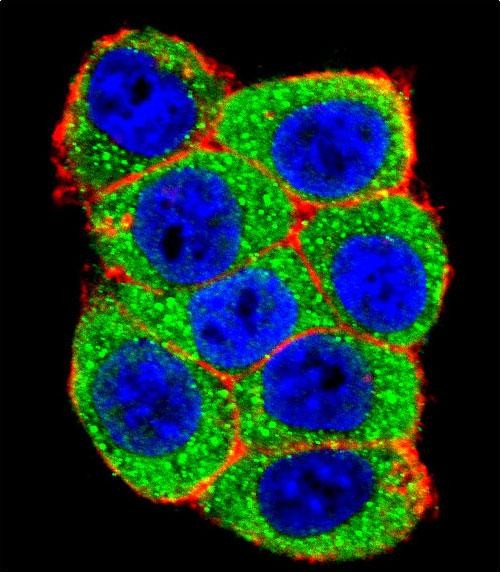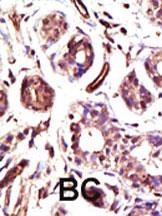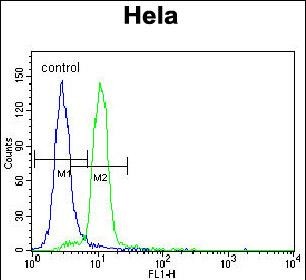UBE3A Antibody (C-term)
Purified Rabbit Polyclonal Antibody (Pab)
- SPECIFICATION
- CITATIONS: 1
- PROTOCOLS
- BACKGROUND

Application
| FC, IF, IHC-P, WB, E |
|---|---|
| Primary Accession | Q05086 |
| Reactivity | Human |
| Host | Rabbit |
| Clonality | Polyclonal |
| Isotype | Rabbit IgG |
| Calculated MW | 100688 Da |
| Antigen Region | 836-865 aa |
| Gene ID | 7337 |
|---|---|
| Other Names | Ubiquitin-protein ligase E3A, 632-, E6AP ubiquitin-protein ligase, Human papillomavirus E6-associated protein, Oncogenic protein-associated protein E6-AP, Renal carcinoma antigen NY-REN-54, UBE3A, E6AP, EPVE6AP, HPVE6A |
| Target/Specificity | This UBE3A antibody is generated from rabbits immunized with a KLH conjugated synthetic peptide between 836-865 amino acids from the C-terminal region of human UBE3A. |
| Dilution | FC~~1:10~50 IF~~1:10~50 IHC-P~~1:50~100 WB~~1:1000 E~~Use at an assay dependent concentration. |
| Format | Purified polyclonal antibody supplied in PBS with 0.09% (W/V) sodium azide. This antibody is prepared by Saturated Ammonium Sulfate (SAS) precipitation followed by dialysis against PBS. |
| Storage | Maintain refrigerated at 2-8°C for up to 2 weeks. For long term storage store at -20°C in small aliquots to prevent freeze-thaw cycles. |
| Precautions | UBE3A Antibody (C-term) is for research use only and not for use in diagnostic or therapeutic procedures. |
| Name | UBE3A (HGNC:12496) |
|---|---|
| Function | E3 ubiquitin-protein ligase which accepts ubiquitin from an E2 ubiquitin-conjugating enzyme in the form of a thioester and transfers it to its substrates (PubMed:10373495, PubMed:16772533, PubMed:19204938, PubMed:19233847, PubMed:19325566, PubMed:19591933, PubMed:22645313, PubMed:24273172, PubMed:24728990, PubMed:30020076). Several substrates have been identified including the BMAL1, ARC, LAMTOR1, RAD23A and RAD23B, MCM7 (which is involved in DNA replication), annexin A1, the PML tumor suppressor, and the cell cycle regulator CDKN1B (PubMed:10373495, PubMed:19204938, PubMed:19325566, PubMed:19591933, PubMed:22645313, PubMed:24728990, PubMed:30020076). Additionally, may function as a cellular quality control ubiquitin ligase by helping the degradation of the cytoplasmic misfolded proteins (PubMed:19233847). Finally, UBE3A also promotes its own degradation in vivo. Plays an important role in the regulation of the circadian clock: involved in the ubiquitination of the core clock component BMAL1, leading to its proteasomal degradation (PubMed:24728990). Acts as transcriptional coactivator of progesterone receptor PGR upon progesterone hormone activation (PubMed:16772533). Acts as a regulator of synaptic development by mediating ubiquitination and degradation of ARC (By similarity). Required for synaptic remodeling in neurons by mediating ubiquitination and degradation of LAMTOR1, thereby limiting mTORC1 signaling and activity-dependent synaptic remodeling (By similarity). Synergizes with WBP2 in enhancing PGR activity (PubMed:16772533). |
| Cellular Location | Cytoplasm {ECO:0000250|UniProtKB:O08759}. Nucleus {ECO:0000250|UniProtKB:O08759} |

Provided below are standard protocols that you may find useful for product applications.
Background
UBE3A interacts with the E6 protein of the cancer-associated human papillomavirus types 16 and 18. The E6/E6-AP complex binds to and targets the p53 tumor-suppressor protein for ubiquitin-mediated proteolysis. It is an E3 ubiquitin-protein ligase which accepts ubiquitin from an E2 ubiquitin-conjugating enzyme in the form of a thioester and then directly transfers the ubiquitin to targeted substrates. It can target itself for ubiquitination in vitro and efficiently promotes its own degradation in vivo. It appears that only unmodified E6-AP molecules can bind efficiently to p53 in the presence of the HPV E6 oncoprotein. UBE3A binds UBQLN1 and UBQLN2. Defects in UBE3A are a cause of Angelman syndrome (AS) [MIM:105830]; also known as 'happy puppet syndrome'. AS is characterized by features of severe motor and intellectual retardation, microcephaly, ataxia, frequent jerky limb movements and flapping of the arms and hands, hypotonia, hyperactivity, hypopigmentation, seizures, absence of speech, frequent smiling and episodes of paroxysmal laughter, and an unusual facies characterized by macrostomia, a large mandible and open-mouthed expression, a great propensity for protruding the tongue ('tongue thrusting'), and an occipital groove. UBE3A contains 1 HECT-type E3 ubiquitin-protein ligase domain.
References
Be, X., et al., Biochemistry 40(5):1293-1299 (2001).
Kleijnen, M.F., et al., Mol. Cell 6(2):409-419 (2000).
Huang, L., et al., Science 286(5443):1321-1326 (1999).
Nuber, U., et al., Eur. J. Biochem. 254(3):643-649 (1998).
Malzac, P., et al., Am. J. Hum. Genet. 62(6):1353-1360 (1998).
If you have used an Abcepta product and would like to share how it has performed, please click on the "Submit Review" button and provide the requested information. Our staff will examine and post your review and contact you if needed.
If you have any additional inquiries please email technical services at tech@abcepta.com.














 Foundational characteristics of cancer include proliferation, angiogenesis, migration, evasion of apoptosis, and cellular immortality. Find key markers for these cellular processes and antibodies to detect them.
Foundational characteristics of cancer include proliferation, angiogenesis, migration, evasion of apoptosis, and cellular immortality. Find key markers for these cellular processes and antibodies to detect them. The SUMOplot™ Analysis Program predicts and scores sumoylation sites in your protein. SUMOylation is a post-translational modification involved in various cellular processes, such as nuclear-cytosolic transport, transcriptional regulation, apoptosis, protein stability, response to stress, and progression through the cell cycle.
The SUMOplot™ Analysis Program predicts and scores sumoylation sites in your protein. SUMOylation is a post-translational modification involved in various cellular processes, such as nuclear-cytosolic transport, transcriptional regulation, apoptosis, protein stability, response to stress, and progression through the cell cycle. The Autophagy Receptor Motif Plotter predicts and scores autophagy receptor binding sites in your protein. Identifying proteins connected to this pathway is critical to understanding the role of autophagy in physiological as well as pathological processes such as development, differentiation, neurodegenerative diseases, stress, infection, and cancer.
The Autophagy Receptor Motif Plotter predicts and scores autophagy receptor binding sites in your protein. Identifying proteins connected to this pathway is critical to understanding the role of autophagy in physiological as well as pathological processes such as development, differentiation, neurodegenerative diseases, stress, infection, and cancer.




